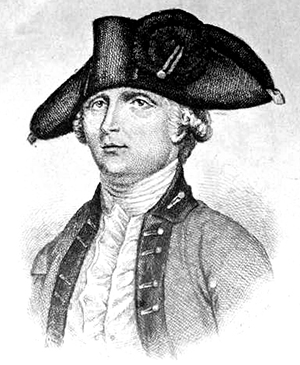Courthouse Ring
"Courthouse ring" refers to a group of politicians and government officials who, by controlling local appointments, increased their power and profits through the collection of fees and the awarding of contracts and jobs. In North Carolina, courthouse rings were most notorious in the late colonial period, although they were also a problem after Reconstruction.
In 1767 royal governor William Tryon believed that the colony's sheriffs stole over half of the poll tax money they collected. An audit in 1770 showed that every county in the colony had at least one defaulting sheriff, and the sheriffs owed the colony more than £64,000 in taxes they had failed to turn over. This excessive embezzlement made it imperative to continue the poll tax far longer than should have been necessary.
 The greed of the courthouse rings in the Piedmont, and the failure of the royal government to address their wrongs, greatly contributed to the disaffection of the backcountry settlers that led to the Regulator Movement. Edmund Fanning (1737-1818), a leading figure in Orange County's courthouse ring, perhaps symbolized the abuses of courthouse rings more than any other man. Fanning, who concurrently served as a member of the Assembly, registrar of deeds, superior court judge, and militia colonel, grew wealthy on his fees at the expense of the common people, whom he treated with great contempt. His offenses were so blatant that he was convicted of extortion in 1768, although the court reserved judgment and he escaped punishment. In September 1770, when a mob of Regulators seized the courthouse in Hillsborough, they also assaulted Fanning and destroyed his house.
The greed of the courthouse rings in the Piedmont, and the failure of the royal government to address their wrongs, greatly contributed to the disaffection of the backcountry settlers that led to the Regulator Movement. Edmund Fanning (1737-1818), a leading figure in Orange County's courthouse ring, perhaps symbolized the abuses of courthouse rings more than any other man. Fanning, who concurrently served as a member of the Assembly, registrar of deeds, superior court judge, and militia colonel, grew wealthy on his fees at the expense of the common people, whom he treated with great contempt. His offenses were so blatant that he was convicted of extortion in 1768, although the court reserved judgment and he escaped punishment. In September 1770, when a mob of Regulators seized the courthouse in Hillsborough, they also assaulted Fanning and destroyed his house.
Reforms to eliminate the power of courthouse rings were implemented very slowly in North Carolina. After the War of the Regulation, there were minor improvements: lawyers' fees were better regulated, some county officers were placed under bond, and some abuses in the handling of tax money and the collection of small debts were curbed. The Constitution of 1776 changed little involving county government. Multiple office holding was restricted by legislation in 1808 and 1809, but sheriffs were not elected by popular vote until after 1829. Throughout the antebellum period, justices of the peace were appointed by the governor on the recommendation of legislators from their counties. Justices of the peace still wielded executive and judicial power through the old county courts until the Constitution of 1868 created a county commission system.
When the Conservatives regained control of the General Assembly after Reconstruction, they passed legislation in 1877 that eliminated the popular election of county commissioners and once again placed the direction of county governments in the hands of the justices of the peace. These measures were made to return the governance of counties with large black or Republican populations to the Conservatives of the Democratic Party; but by placing county authority in the hands of small groups of influential officials, they also permitted courthouse rings to flourish. The right of voters to elect their own county commissioners was restored in all counties by 1905.
References:
Robert L. Ganyard, The Emergence of North Carolina's Revolutionary State Government (1978).
Guion G. Johnson, Ante-Bellum North Carolina: A Social History (1937).
Hugh T. Lefler and Albert R. Newsome, North Carolina: The History of a Southern State (1963).
William S. Powell, North Carolina through Four Centuries (1989).
Additional Resources: (accessed December 5, 2012).
Whittenburg, James P. "Planters, Merchants, and Lawyers: Social Change and the Origins of the North Carolina Regulation." The William and Mary Quarterly Third Series. Vol. 34, No. 2. Apr. 1977. pp. 215-238. http://www.jstor.org/stable/1925314
Image Credits:
"Photograph, Accession #: H.1946.14.219." 1900-1920. North Carolina Museum of History.
1 January 2006 | Norris, David A.